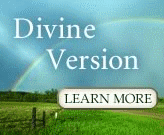|
THANK YOU for reading
ONE. You’ve made a great decision. ONE is the most complete and
authoritative unified gospel available anywhere—at any price.
Because ONE is the
seamless verbatim unification of the Gospels of Matthew, Mark, Luke and John,
you may not even notice that you are reading the actual text of all four Gospels
at the same time! With 3,000 references in the
Unification Index back to the source Gospels, each clause in all of the
Gospels is accounted for in ONE. And, the new
Gospel Index allows you reference from the source Gospels into ONE,
and the new
Word Index (both available online) gives you power over individual words in
the text of ONE. Three separate powerful indices to give you
control over the text!
Generally speaking, there are
two ways to enjoy ONE, and they are both wonderful!
The first way is to
just read the work—straight through—as one may read a novel. The unification
process makes reading the Gospel of Jesus easier than ever. Even so, you can
read ONE with comfort that every clause you read is authoritatively
reconciled back to the original source Gospels. The second way is
to savor ONE through deepened study, by referencing back to your favorite
version of the Gospels, on a clause-by-clause basis. Every clause in each of
the four Gospels is referenced in ONE. ONE is an authentic parallel of
all four Gospels within a seamless harmony of the Gospels!
There is no text in the original four Gospels
not accounted for in the text of
.
has 3,000 references back
to the original source Gospels. Easy as 1-2-3:
- 1. Read any clause in
.
- 2. Note the citation, e.g.,
1707 in the example below.
- 3. Reference the citation back to the
Unification Index to determine from which original texts the ONE text
is derived. ONE:1707 is derived from
Matthew 18:21.
Legend:
- Matthew
- Mark
- Luke
- John
- Matthew and Mark Only
- Matthew, Mark and Luke
Only (the "Synoptic Gospels")
- All Gospels
- Teaching Unending Forgiveness
This example illustrates how an important
teaching is clarified by unification of the Gospels. The teaching of
unending forgiveness is only contained in two of the four Gospels: Matthew
and Luke. In Luke, however, there is a condition of repentance.
Often the Gospels of Matthew and Luke are separated by the Gospel of Mark.
Accordingly, the reader will not mentally unify the teachings because of the
remoteness of the lessons:
In Matthew 18:21-22, the command to forgive is as follows:
"Then
Peter approaching asked him, 'Lord, if my brother sins against me, how
often must I forgive him? As many as seven times?' Jesus answered, "You
should forgive him, not seven times but seventy-seven times."
In Luke
17:3-4, it is as follows: "Be on your guard! If your brother sins,
rebuke him; and if he repents, forgive him. And if he wrongs you seven
times in one day and returns to you seven times saying, ‘I am sorry,’
you should forgive him."
See
ONE:1707-1711. It reads in the text as follows:
1707 Then Peter approaching asked him,
"Lord, if my brother sins
against me, how often must I forgive him? As many as seven times?”
1708 Jesus answered,
1709 “Be on your guard! If your brother sins,
rebuke him; and if he repents, forgive him. 1710
And if he wrongs you
seven times in one day and returns to you seven times saying, ‘I am
sorry,’ you should forgive him. 1711
I say to you, not seven times but
seventy-seven times."
So, in the final text of ONE, it reads
smoothly as follows, not only with greater impact and clarity, but also with
the full revelation of Jesus' message:
| 1707 Then Peter approaching asked him, "Lord, if my brother sins
against me, how often must I forgive him? As many as seven times?” 1708 Jesus answered, 1709 “Be on your guard! If your brother sins,
rebuke him; and if he repents, forgive him. 1710 And if he wrongs you
seven times in one day and returns to you seven times saying, ‘I am
sorry,’ you should forgive him. 1711 I say to you, not seven times but
seventy-seven times." |
Even though the text reads smoothly for the
casual reader, the
citations provide an authoritative reference back to the
source Gospels for the student, scholar, preacher.
|
|
Matthew |
Mark |
Luke |
John |
|
|
|
|
|
|
|
|
|
|
|
1707 |
T18:21 |
|
|
|
1707 |
Teaching Unending Forgiveness; Seventy-Seven Times |
|
1708 |
T18:22 |
|
|
|
1708 |
|
|
1709 |
|
|
L17:3 |
|
1709 |
|
|
1710 |
|
|
L17:4 |
|
1710 |
|
|
1711 |
T18:22 |
|
|
|
1711 |
|
- Teaching by Simile of Salt
This example
illustrates how three of the Gospels, Matthew, Mark, Luke and John (the
"Synoptic Gospels") have subtle distinctions in the text. They all
contain the simile of salt, but have nuances that, when unified, enrich the
teaching. If not unified, the subtleties are difficult to recall and
mentally to unify:
485 “You
are the salt of the earth. 486 Salt
is good. 487 But if salt loses its
taste, with what will you restore its flavor? It is fit neither for the
soil nor for the manure pile but to be thrown out and trampled underfoot.
488 Everyone will be salted with
fire. 489 Keep salt in yourselves
and you will have peace with one another. 490
Whoever has ears to hear ought to hear.”
Only Matthew has
[485], only Luke has [486] and [490], and only Mark has [488] and [489].
The Synoptic Gospels have similar text in [487]. The follow shows how the separate concepts
are integrated with no loss of verbatim integrity, and, yet, allowing the
reader to easily grasp the entire message of Jesus:
|
485 “You
are the salt of the earth. 486 Salt
is good. 487 But if salt
loses its taste, with what will you restore its flavor? It is fit neither
for the soil nor for the manure pile but to be thrown out and trampled
underfoot. 488 Everyone will be salted with fire. 489
Keep salt in yourselves and you will have peace with one another. 490
Whoever has ears to hear ought to hear.” |
|
|
Matthew |
Mark |
Luke |
John |
|
|
|
|
|
|
|
|
|
|
|
485 |
T5:13 |
|
|
|
485 |
Teaching by Simile of Salt |
|
486 |
|
|
L14:34 |
|
486 |
|
|
487 |
T5:13 |
R9:50 |
L14:35 |
|
487 |
|
|
488 |
|
R9:49 |
|
|
488 |
|
|
489 |
|
R9:50 |
|
|
489 |
|
|
490 |
|
|
L14:35 |
|
490 |
|
- The Crucifixion; Father Forgive Them
This example demonstrates how each of the
four Gospels tell only a piece of the story of Jesus' crucifixion.
Unless you read ONE, you need to gain your understanding of the
circumstances in bits and pieces as you read each of the Gospels.
2778 And when they came to a place
called Golgotha (which means “Place of the Skull”), 2779
they gave Jesus wine to drink mixed with myrrh and gall. But when he had
tasted it, he refused to drink it. 2780
It was nine o’clock in the morning when they had
placed him onto the cross. 2781
After being placed on the cross, 2782
Jesus said: “Father, forgive them, they know not what
they do.”
2783 Then,
the soldiers took his clothes and divided them into four shares, one share
for each. They also took his tunic, but the tunic was seamless, woven in one
piece from the top down, so 2784
they divided his garments by casting lots for them to see what each should
take. 2785 They said to one another,
“Let’s not tear it, but cast lots for it to see whose it will be,” in order
that the passage of scripture might be fulfilled: They divided my garments
among them, and for my vesture they cast lots.
So that is what the
soldiers did. 2786 Then they sat
down and kept watch over him there.
2787 Pilate also had an
inscription written and put on the cross and placed over his head, it read,
“Jesus the Nazorean, the King of the Jews.” 2788
Now, many of the Jews read this inscription, because
the place where Jesus was crucified was near the city. It was written in
Hebrew, Latin, and Greek. 2789 So
the chief priests of the Jews said to Pilate, “Do not write ‘The King of the
Jews,’ but that he said, ‘I am the King of the Jews.’” 2790
Pilate answered, “What I have written, I have written.”
This text demonstrates how all four Gospels
separately describe interwoven circumstances, which, if not unified
textually, are extremely difficult to grasp. As shown in the
coloration (assuming it can be shown on the resolution/monitor settings on
your screen), there is important text only in John (Pilate's comments
regarding the inscription), important text only in Luke ("Father forgive
them..."), important text only in Mark (time of being placed on the cross),
and text that is generally common to all four Gospels at times, and, at
other times, only two or three of the Gospels. With ONE, the
reader gains the verbatim text, but gains a more seamless understanding of
the Gospels--greater clarity and impact, while maintaining integrity of the
original text.
| 2778 And when they came to a
place called Golgotha (which means “Place of the Skull”), 2779
they gave Jesus wine to drink mixed with myrrh and gall. But when he had
tasted it, he refused to drink it. 2780 It was nine o’clock
in the morning when they had placed him onto the cross. 2781
After being placed on the cross, 2782 Jesus said: “Father,
forgive them, they know not what they do.” 2783 Then, the
soldiers took his clothes and divided them into four shares, one share for
each. They also took his tunic, but the tunic was seamless, woven in one
piece from the top down, so 2784 they divided his garments by
casting lots for them to see what each should take. 2785 They
said to one another, “Let’s not tear it, but cast lots for it to see whose
it will be,” in order that the passage of scripture might be fulfilled: They
divided my garments among them, and for my vesture they cast lots.
So that is what the soldiers did.
2786 Then they sat down and kept watch over him there.
2787 Pilate also had an
inscription written and put on the cross and placed over his head, it read,
“Jesus the Nazorean, the King of the Jews.” 2788 Now, many of the
Jews read this inscription, because the place where Jesus was crucified was
near the city. It was written in Hebrew, Latin, and Greek. 2789
So the chief priests of the Jews said to Pilate, “Do not write ‘The King of
the Jews,’ but that he said, ‘I am the King of the Jews.’” 2790
Pilate answered, “What I have written, I have written.”
|
|
|
Matthew |
Mark |
Luke |
John |
|
|
|
|
|
|
|
|
|
|
|
2778 |
T27:33 |
R15:22 |
L23:33 |
J19:16 |
2778 |
The Crucifixion |
|
2779 |
T27:34 |
R15:23 |
|
|
2779 |
|
|
2780 |
|
R15:25 |
|
|
2780 |
|
|
2781 |
T27:35 |
R15:24 |
L23:34 |
|
2781 |
|
|
2782 |
|
|
L23:34 |
|
2782 |
|
|
2783 |
|
|
|
J19:23 |
2783 |
|
|
2784 |
T27:35 |
R15:24 |
L23:34 |
|
2784 |
|
|
2785 |
|
|
|
J19:24 |
2785 |
|
|
2786 |
T27:36 |
|
|
|
2786 |
|
|
2787 |
T27:37 |
R15:26 |
L23:38 |
J19:19 |
2787 |
|
|
2788 |
|
|
|
J19:20 |
2788 |
|
|
2789 |
|
|
|
J19:21 |
2789 |
|
|
2790 |
|
|
|
J19:22 |
2790 |
|
In 230 pages, get the entire verbatim
unified text of the Gospels. Plus, 3,000 references, in 50
pages, to the four source Gospels allowing the preacher and scholar to
research the text to the original works.
For the casual reader,
reads as
easily as a novel. For the preacher and scholar, ONE is a reference
work that is fully indexed to the original source Gospels. Leverage your
time by reading ONE.
is a truly unique and important work
that everyone should read now. This
is the ORIGINAL printing, released November, 2006. Beautifully bound. Great gift. Buy here now.
Copyright 2006. Original Printing.
320 pages, including 56 page Unification Index
7.5" x 5" x .75"; 15 oz.
ISBN-10: 0-9789906-0-9; ISBN-13: 978-0-9789906-0-2
Softbound.
Buy E-Book.
Buy Audio CD.
Other Works by Gregg R. Zegarelli:
ONE - Universal Version
Now Available in
Family 5-Paks - Buy 4 Get 1 Free.
Makes great
gifts for friends and family.
Limited Time - Limited Quantities!
$124.75 $89.96

|








